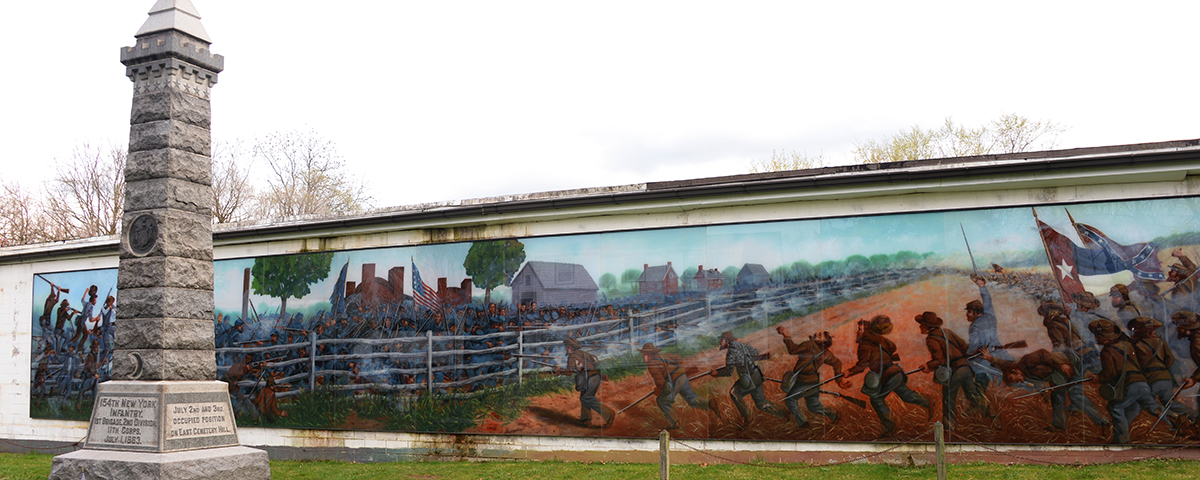Gettysburg’s Coster Avenue: The Brickyard Fight and the Mural
Mark H. Dunkelman
Gettysburg Publishing, 2018, $18.95
For a copy of the book signed by author Mark Dunkelman, go to shop.gettysburgpublishing.com
[/box]
There are some stories that just have to be shared because they are an essential part of the author’s sense of who he is. Into this category falls Mark Dunkelman’s paean to his lifetime connection with a seldom studied, rarely visited, corner of Gettysburg’s hallowed ground.
Known to Civil War aficionados as the brief but intense firefight in John Kuhn’s brickyard on the afternoon of July 1, Dunkelman’s connection spans a lifetime and includes a familial link, years of historical research, and artistic pursuits honed since his days as a student. He has combined these passions over the past 40 years in order to bring a mural he designed and painted on the extended concrete wall of the Coldsmith Roofing Company, located on Coster Avenue, into the mainstream of Gettysburg National Military Park’s historical record.
 The first half of Dunkelman’s booklet concerns itself with Civil War history—namely the clash between an inexperienced Union brigade of four undermanned regiments commanded by a newly minted, 23-year-old colonel, Charles R. Coster, and two Confederate brigades of eight veteran Louisiana and North Carolina regiments. Dunkelman;s connection as a historian comes from his interest, since childhood, in the 154th New York Infantry that his great-great-grandfather joined the more than a year later and his determination to write a history of that regiment.
The first half of Dunkelman’s booklet concerns itself with Civil War history—namely the clash between an inexperienced Union brigade of four undermanned regiments commanded by a newly minted, 23-year-old colonel, Charles R. Coster, and two Confederate brigades of eight veteran Louisiana and North Carolina regiments. Dunkelman;s connection as a historian comes from his interest, since childhood, in the 154th New York Infantry that his great-great-grandfather joined the more than a year later and his determination to write a history of that regiment.
The first day’s action at Gettysburg was going well for the gray invaders when Coster’s brigade was ordered to support hard-pressed elements of the 11th Corps, then being driven back through the town. When hastily thrown into the fray, Coster’s regiments, the 134th and 154th New York and the 27th Pennsylvania, numbered less than 1,000 men. The 73rd Pennsylvania was held in reserve and didn’t participate in the fight. The blue coats encountered 3,000 hard charging gray marauders already flush with success in the day’s fighting. Dunkelman concedes: “Under the circumstances, Coster’s stand in the brickyard was inevitably brief.” Quickly outflanked and outgunned, the remnants of Coster’s broken regiments later joined other Union troops regrouping on Cemetery Hill.
The importance of the encounter depends on whose accounts you accept. Dunkelman posits that, brief though it was, the Brickyard Fight bought critical time for other Union regiments to regroup into defensible positions. Other historians mention it only in passing, more concerned with the day’s more momentous events. What can’t be argued is the staggering losses suffered that afternoon. Union casualties numbered 269 killed and wounded and an astonishing 301 captured. Confederate losses are estimated at just more than 200. For less than half an hour of fighting, 778 total casualties makes the Brickyard Fight one of the war’s fiercest encounters.
In 1890, veterans of the 154th New York erected a regimental monument on the site of the brickyard bloodletting. Over the years, the city of Gettysburg encroached around the monument and it became lost in the midst of urban growth. This is where Dunkelman again enters the story, this time as an artist. A visit to the brickyard site in 1970 revealed the monument backed by an 80-foot concrete wall of a roofing company. But Dunkelman envisioned something much grander.
A reader’s interest in mural painting, restoration, repainting, preservation techniques, and repainting yet again, will determine how relevant the book’s second half is to the story. There is no doubt, however, that since 1970 Dunkelman pursued this aspect of the brickyard story with a passion. He believed that “a concrete block wall would form an unsightly backdrop to the monument of a regiment that had come to mean so much to me.” But how “to make the wall disappear.” Wouldn’t a mural, like the famous Gettysburg Cyclorama, encourage more visitors to this neglected part of the battlefield and gain respect and understanding for the men who fought there? In his mind’s eye, “Visitors would link the present warehouse wall mural to the Coster Avenue past, just as the 154th’s regimental veterans had tied Coster Avenue to Kuhn’s brickyard at the dedication their monument in 1890.”
How well he has succeeded, Dunkelman admits, “others will judge.” But using this slender volume, a lovingly restored mural, and Mark Dunkelman’s determined preservation efforts as evidence, the uncommon valor and selfless sacrifice shown in John Kuhn’s brickyard on that hot July afternoon will enrich Gettysburg’s heritage for generations to come.





